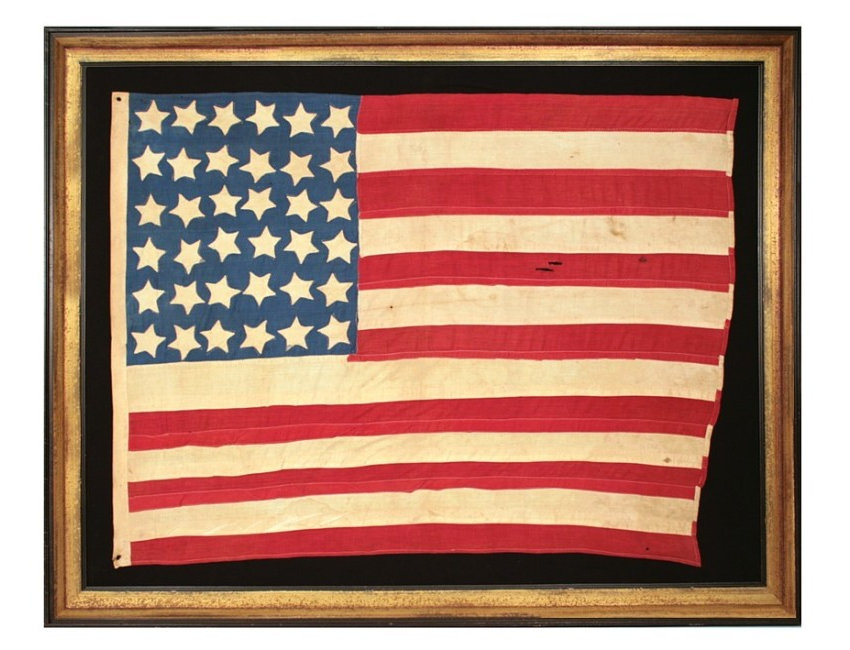|
36 STARS ON A BRIGHT BLUE CANTON, CIVIL WAR ERA, 1864-1867, NEVADA STATEHOOD, A GREAT FOLK EXAMPLE
|
|

|
Description: |
|
36 STARS ON A BRIGHT BLUE CANTON, CIVIL WAR ERA, 1864-1867, NEVADA STATEHOOD, A GREAT FOLK EXAMPLE:
36 star American national flag of the Civil War era with outstanding collector traits. Haphazard rows of fat, starfish-shaped stars fill most of the confines of a brilliant, cornflower blue canton that is unusually tall and narrow. The stars point in various directions on their vertical axis, which adds a great deal of character to its overall design, that also bears other traits of visual interest. Note in particular the crude piecing of the thirteen, red and white, cotton stripes, which are joined with a treadle machine but in an ill-planned manner that results in great variation in width as well as general irregularity. Note how the 4th red stripe actually falls slightly below the canton, and that the level of each stripe does not line up with its corresponding partner on the reverse. This can clearly be seen at the fly end, where the flag is turned back and bound to repair obvious use in an outdoor environment. Clearly this seamstress or group of seamstresses had not before made many flags, so the process of aligning the necessary components so that they could be viewed on both sides presented a challenge they had not before faced. This fact is also evidenced in the sewing of the stars, which do not line up on the obverse and reverse sides. It is just this kind of homemade charm, however, that fuels interest in early flags among both collectors and folk art enthusiasts. Even the wavy line of the fly end binding adds whimsical appeal.
The stars are hand-sewn, made of cotton, and double-appliqu�d. The flag�s cotton canton is joined to the stripe field with hand-stitching and there is a cotton hoist with two hand-sewn grommets. The flag�s proportions are rather close to square, but Union Civil War infantry battle flags were nearly square (commonly 6 x 6 � feet), so the form is not as unusual as it appears. Even the proportions of the canton, being taller than it is long, is shared by many Civil War battle flags. This was almost certainly not the flag�s original length, however, and it is difficult to determine just how long it was before being properly hemmed so that it could see further use during this highly patriotic and heroic period. In any event, the present size is very small in 19th century terms, which is a plus to both casual and serious collectors. Most 19th century flags with sewn construction were 8 feet in length or greater, making them difficult to display in an indoor setting.
Lincoln pushed Nevada through to statehood on October 31st, 1864, during the Civil War, and just 8 days before the November election. The territory�s wealth in silver was attractive to a nation struggling with the debts of war and so increased support for the Republican ticket. While the 36th star wasn't officially added until July 4th of the following year, some flag-makers would have begun adding the 36th star as early as July of 1864, several months before the addition of Nevada actually occurred and almost all would have added it after Nevada was in. This would be especially true among homemade flags like this one. Adding stars before they were official was common practice during the late 19th century and reflects both the nation's desire for Westward Expansion and the hope of flag-makers to bring new star counts to market before their competitors. The 36 star flag was officially replaced by the 37 star flag in 1867, following the addition of Nebraska.
Mounting: The flag has been hand-stitched to 100% silk organza for support on every seam. It was then stitched to a background of 100% cotton twill, black in color. The black cotton has been washed to reduce excess dye. An acid-free agent was added to the wash to further set the dye and the fabric was heat-treated for the same purpose.
Condition: There is minor foxing and staining. The fly end was probably turned back during the course of its use, as previously noted. |
| Inventory Number: |
|
|
|
Dealer |
Jeff R. Bridgman American Antiques, llc |
| Contact |
Jeff Bridgman |
Phone: (717) 502-1281 |
|
| Period: |
19th Century (1801-1900) |
|
| Date: |
1864-1867 |
|
| Origin: |
American |
|
| Condition: |
see description |
|
| Measurements: |
flag: 39" x 53.5", frame: 50" x 64.5" |
|
| Inventory |
Other Inventory by this Dealer |
|
| Web-site: |
http://www.jeffbridgman.com |
|
| Price: |
SOLD |
|
| E-mail: |
Inquire
|
|
Click thumbnail
to view larger
|
Views: 2769 |
|
|
|
